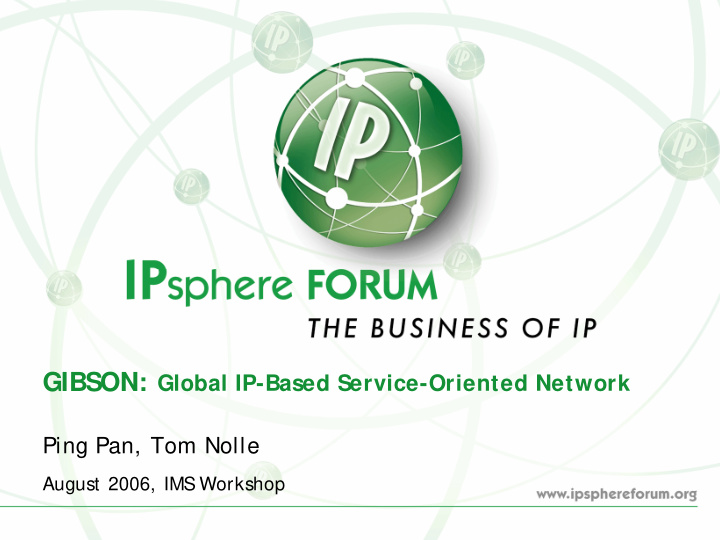



GIBSON: Global IP-Based Service-Oriented Network Ping Pan, Tom Nolle August 2006, IMS Workshop
Why Are We Here? • Access/ metro and backbone networks may belong to different carriers or business entities: Different technologies among providers (Metro/ Access and Core • networks) Different service “ values” : some per-flow on video streams, or • per-aggregation group on voice sessions Regulatory issues such as intercept/ surveillance which may result • in routing and aggregation decisions • No control over user traffic within the core: Core networks have no ability or incentive to provide special • treatment on important user flows Application-based congestion and flow control (e,g, TCP) may not • be sufficient Existing mechanisms won’ t scale as end-user applications become • more bandwidth-intensive and delay-sensitive. 2
Today’s Network (Example) Service negotiation… so what? IMS IMS Control Control Data Plane Data Plane Data Plane Network 1 Network 2 Network 3 Real-time video stream: no congestion control, no QoS… no service guarantee 3
What We Need to Address • Data aggregation at edge: The data flows may be in many format types depending on the services: • Ethernet VLAN, TCP, RTP, MPEG and HTTP, etc. There may be many data flows (in the range of millions) at various • granularity S ome flows need to have special treatment: rate and delay guarantee, • encryption, redundancy and prot ection, performance monitoring, rate adaptation, traffic acceleration, address remapping, etc. • Business-based policy routing at network boundary: The policies are driven by bilateral or multi-lateral business arrangement • Within core net work, the policies may be stat ic and long-lasting • At access edge, the policies may be somewhat dynamic depending on • service and user behavior • S ervice binding between control-plane and data-plane: Map service parameters (SIP/ SDP) to network “ tunnels” • Note: in IMS, control messages and data packets do not necessarily • traverse through the same path. S ome logical entity needs to correlate flow information from CSCF to packet switches. 4
GIBSON (Global IP-Based Service-Oriented Network) • Provide consistent edge-to-edge per-flow forwarding behavior • Open interface for business service creation and provisioning • Operate in both intra-provider and inter-provider environment • Flow type agnostic – capable of processing flows in any format • Transport agnostic - Independent of underlying network transport tunneling mechanism • Keep service devices less dependency on IP routing • Keep data transport gears out of service control plane (KIS S ) 5
GIBSON Architecture Business Services IPsphere SMS Mapping / Aggregation Policy Routing Core Metro Metro Network Network Network A B C D Application Stream Ethernet MPLS Tunnel Optical Pseudowire Pseudowire Pseudowire User User Segment Segment Segment Flow Flow GIBSON Pseudowire 6
Why Pseudowire? • Transport Agnostic: Pseudowires can support IP and Ethernet, and can even remap to optical. Gibson • Pseudowires also recognize multipoint transport behavior and can exploit it at the service level to facilitate multipoint services • IP-friendly Per IETF specification, Pseudowires are provisioned and controlled via IP control • plane • Flow type agnost ic Pseudowires can encapsulate any type of data flows. As defined today, Pseudowires • can encapsulate Layer-1 flows in S ONET/ S DH format (the technique is known as Circuit Emulation), Layer-2 flows such as ATM, Frame Relay, PPP and Ethernet, and IP • Application-awareness In the context of GIBS ON, Pseudowires can be used to encapsulate application-aware • streams such as RTP, MPEG or a group of flows. Application-awareness will enable the GIBS ON endpoints to leverage a number of techniques for congestion control, rate adaptation and protection • SLA capable Pseudowire technique can provide QoS , protection and restoration and congestion • control functionality at per-flow basis. 7
Interfaces in GIBSON S3 (Pseudowire routing) S1 S2 Service Service Gibson Gibson Gibson access access Endpoint Endpoint Endpoint device device Access: lightweight signaling Aggregation S5 (Meshed VPN) Gibson S4 Endpoint Pseudowire Termination Transport Tunnels Pseudowires within GIBSON-enabled network Data flows in Non-Gibson best-effort IP networks Endpoint 8
GIBSON: IMS User Case 3. Negotiating with tunnel identity IMS IMS Control Control 2. Populate IMS 2. Populate IMS IPsphere IPsphere IPsphere Agent Agent Agent 1. tunnel setup 1. tunnel setup 1. tunnel setup GIBSON GIBSON GIBSON Endpoint Endpoint Endpoint Network 1 Network 2 Network 3 Media Flow 9
GIBSON: IMS User Case (cont. 1) IMS IMS Control Control 4. Download session data 4. Download session data IPsphere IPsphere IPsphere Agent Agent Agent 5. Policy routing 5. Policy routing 6. Trigger PW setup 6. Trigger PW setup GIBSON GIBSON GIBSON Endpoint Endpoint Endpoint Network 1 Network 2 Network 3 Media Flow 10
GIBSON: IMS User Case (cont. 2) IMS IMS Control Control IPsphere IPsphere IPsphere Agent Agent Agent 7’. PW Routing 7. PW Setup 7. PW Setup GIBSON GIBSON GIBSON Endpoint Endpoint Endpoint Network 1 Network 2 Network 3 Media Flow 8. Data aggregation, grouping and mapping 11
What’s Next • Extend the concept in other applications Video-on-Demand • VPN • … • • Demonstrate IMS functionality in the near future For example, the year-end BT S howcase • • Complete the detailed mechanism work in IETF A number of carriers and vendors are working together on • • Dry-Martini • PW Protection • PW Congestion • MHOP PW Routing 12
Recommend
More recommend